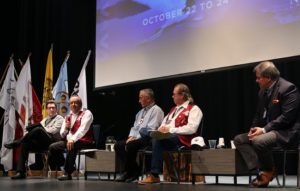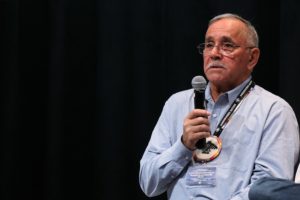Striving for prosperity while protecting the land

By Kelly Anne Smith
NORTH BAY— Nipissing First Nation Deputy Chief Muriel Sawyer welcomed delegates to Nipissing University, situated on the traditional lands of Nipissing First Nation, for the Anishinabek Nation Lands, Resources and Economic Development Forum Kina-Gego-Naabadosin— Everything is Connected from Oct. 22-24.
Deputy Chief Sawyer thought the Anishinaabemowin name for the forum was fitting.
“In the language, ‘kina-gego’ means ‘everything is all so intertwined and interconnected.’ We are all interconnected as human beings. We need to start working in collaboration with one another. But we also need listen and educate each other because sometimes we are hearing but we are not really listening.”
Sawyer states we have to understand what working on relationships really means for the future in terms of sustainability.
“How interconnected are we to something that we are willing to throw away or destroy? If we really do believe in that, how do we go about it?” she says, noting that these are dire times. “We talk about things but how productive are we? What does that mean for resources, economic development, our land? And what partnerships and what relationships are going to be fostered?”
Day 1 of the forum started off with a Joint Plenary Session and Discussion with Anishinabek Nation Grand Council Chief Glen Hare and Regional Deputy Grand Council Chiefs; President and Vice-Chancellor of Nipissing University Dr. Mike DeGagné; and Northern Ontario Regional Director for the Ministry of Transportation Eric Doidge. Doidge talked about how climate change is forcing opportunities for Indigenous partnerships to build new roads to replace the ice road network.
Grand Council Chief Hare said climate change is in the forefront with young Indigenous activists.
“The youth are calling for action on climate change. We must all listen to them. They want something to happen so we should be there to lead them.”

Pierre Debassige from M’Chigeeng First Nation is a strong youth voice representing the Lake Huron Region on the Anishinabek Nation Eshekenijig Advisory Council.
“I did grow up on the land. I did grow up with culture. Youth like Autumn [Peltier], Greta [Thunberg] and other influential youth leaders can pull youth into the picture and start a whole new generation of leaders. My grandfather taught me you only take what you need, not more, even in abundance. We can’t keep taking and taking.”
On the panel, Grand Council Chief Hare insisted, “We have to leave something good, something strong for the youth to carry on.”
Grand Council Chief Hare also put forth a recommendation to the government to protect the water along the shores of our great lakes.
“If we are going to bury this nuclear waste, put it at least 50 km if not 100 km from the shore. Once you ruin that water, it’s hazardous for everybody. And don’t let anyone tell you it will never happen.”
The forum explored finding balance in protecting the environment while also being prosperous from the land. Presentations on mining innovations and Canada’s new Impact Assessment System, along with Breakout Sessions such as Species at Risk and Roads, Regulatory Updates and the Agri-Food Environmental Plan, GIS and Mapping Projects, and others, took place over the course of the three-day forum.
Northern Superior Regional Deputy Grand Council Chief Edward Wawia holds the lands and resources portfolio. He says the forum showcases sustainability of our resources.

“The hardest part is how do we get the true connection between protecting the environment and benefitting from our resources?” questioned Wawia. “For so many years we’ve been left out of the picture in the mining industry and the forest industry. They’ve taken what they needed from the land and left us out of it…With the Anishinabek Nation helping our 40 First Nations, we’re ensuring that First Nations are part of everything right from day one with planning and exploration…We are making sure that proper, full environment assessments of each area is being done. Now, with the mining industry, they have to have a closure plan. They have to afford to return land to a natural pristine state and to have never-ending monitoring.”
On forestry, Wawia calls for government funding to educate Indigenous forestry workers.
“Our First Nations are involved and on the planning teams now. But we don’t have people properly trained. I recommended to the [Ministry of Natural Resources and Forestry] that they have to provide training to our people. We don’t have the capacity to train them on our own.”
Grand Council Chief Hare said First Nations must be included on projects, including the Ring of Fire.
“We make a difference. We need each other. We want to be part of the decision-making. They are deciding on our lands, our communities and our backyards. We want to have a say. We will make decisions together as a whole in Ontario. That’s all we’ve been asking for.”


